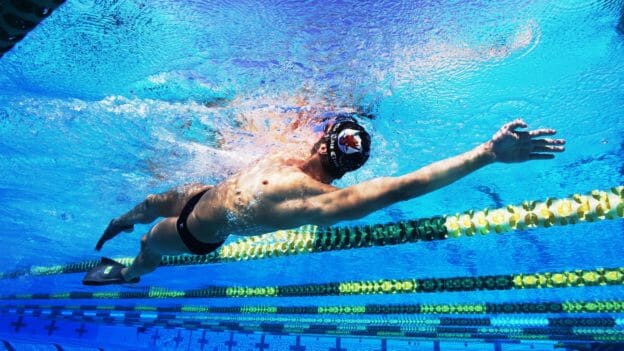In Backstroke, Stroke Rate is the Highest Priority
The fundamentals of good backstroke technique are not much different than with good freestyle technique. Neither are the biomechanics of a good technique much different with the two strokes. It always surprises me when a swimmer can do freestyle well, yet struggles with backstroke, or vice versa. Among the many swimmers we teach at The Race Club, it is not uncommon for us to find that situation. Usually, that means the swimmer is not applying the fundamentals of a good freestyle the same way in backstroke.
Good backstroke technique is simpler to teach and learn than good freestyle technique because it is less complicated. There are fewer options. All backstroke races are 200 meters or less, so all fast backstrokers use a shoulder-driven technique. In backstroke, there is no place for either a hybrid or a hip-driven technique.
Among elite backstrokers, all use a high-octane (straight arm) vertical recovery. The last person at an elite level who used a bent arm in backstroke recovery was likely Adolph Kiefer, who won the 1936 Olympic gold medal in Berlin. Since then, all the recoveries among great backstrokers have been done with a straight arm. The straight arm recovery in backstroke generates more coupling energy for the pulling hand, and the vertical recovery is easier to achieve (compared to freestyle) because the anatomy of the shoulder joint enables much more flexion (forward motion) than extension (backward motion).
The ten or so techniques that are all important in teaching good freestyle technique also apply to backstroke. While not to take away from the importance of having good body and head positioning, proper pulling and kicking motion, and the correct body rotation, in backstroke, using the appropriate stroke rate has the highest priority. With the shorter distances of backstroke, there are only three options for backstroke stroke rate- fast, faster, and fastest. Most swimmers achieve none of these stroke rates in backstroke.
At The Race Club, we encourage backstrokers to train and race at three different stroke rates. For the 200, we encourage stroke rates between 86-90 per minute. For the 100, we encourage stroke rates of 100-105 per minute. For the 50, the stroke rates need to be 110-120 per minute, or even higher, if possible. In the 200 IM, the backstroke stroke rate should be around 86 per minute and slightly less, perhaps 83 per minute, in the 400 IM. Though the size of the swimmer and length of the arms does influence the stroke rates slightly, it is not that significant. Even Matt Grevers, at 6 feet 8 inches, won the Olympic gold medal in the 100-meter backstroke with a stroke rate near 100. Reagan Smith set the two women’s world records in the 100-meter and 200-meter backstrokes in 2019 using stroke rates of 108 and 92 per minute, faster than anyone else in the race.
In this week’s Race Club video release, you will see how one of the world’s fastest backstrokers, Amy Bilquist, learns to increase and sustain her higher stroke rate. Amy, who is over 6 feet tall, applies the important speed and stroke rate drills she learned at The Race Club in a test set of 8 x 25 backstroke on short rest. We hope that this video and other Race Club-related videos with Amy, available in our Lane 2 and Lane 3 subscription, will help you increase your backstroke stroke rate and achieve a faster swim.
Yours in Swimming,
Gary Sr.

